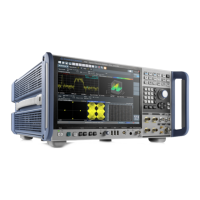Measurements and Results
R&S
®
FSW
219User Manual 1173.9411.02 ─ 43
This measurement requires the Noise Power Ratio (NPR) Measurement firmware
option R&S FSW-K19.
● About Noise Power Ratio (NPR) Measurements.................................................. 219
● NPR Basics...........................................................................................................219
● NPR Results..........................................................................................................221
● NPR Configuration................................................................................................ 222
● Generator Setup....................................................................................................226
● Generator Frequency Coupling.............................................................................231
● How to Perform NPR Measurements....................................................................233
● Measurement Example......................................................................................... 234
7.5.1 About Noise Power Ratio (NPR) Measurements
The noise power ratio is defined as the relationship between the total power density in
a channel and the noise power density. The noise power ratio is commonly used to
describe the distortion caused by in-band multi-carrier intermodulation in a wideband
satellite channel. A satellite can be considered to be a "transparent transponder". It
receives the uplink signal, amplifies it, translates the frequency, amplifies it more, and
finally retransmits it. Typically, the signal contains a large number of carriers. To mea-
sure the in-band distortions of specific carriers in a satellite DUT, notch filters are inser-
ted inside the channel. Notch filters remove the effects of the underlying subcarriers
from the signal. Thus, the distortion of these carriers caused by the others can be
determined.
The R&S FSW noise power ratio measurement allows you to specify your satellite
channel and up to 25 notch filters in your measurement setup. For a more general
measurement, the bandwidth on which the total power density is based can be
selected freely. As a result, the channel power density, the notch power density, and
the noise power ratio are calculated.
7.5.2 NPR Basics
Some background knowledge on basic terms and principles used in noise power ratio
measurements is provided here for a better understanding of the required configuration
settings.
Channel bandwidth, integration bandwidth and notch bandwidth
The Channel Bandwidth defines the width of the channel, or general measurement
range. The displayed span usually depends on the channel bandwidth (span = channel
bandwidth * 1.1)
The Integration Bandwidth defines the frequency range over which measurement
results are actually calculated. By default, it is the same as the channel bandwidth, but
you can define any other value, smaller or larger, as well.
The Notch Bandwidth (Absolute / Relative to Channel BW) defines the width of the
notches, if you define any.
Noise Power Ratio (NPR) Measurement

